|

Control Hierarchies in Complex Artifacts
________________________________________________________________________________
This paper was written in an attempt to state what I had learned about environmental form for a broader audience of engineers and designers ( not necessarily in architecture). I believe the hierarchical structures we find in the built environment can be found in other complex configurations ( like airplanes, chips, cars, etc.) as well. To clarify such a common structure in complex forms, an exposition of the concepts involved had to be given without direct reference to environmental form, but illustrated by diagrammatic representations of the hierarchies involved. The discipline imposed on myself this way forced me to verify the logic behind the concepts I had advocated for some time. It may be helpful in this way to the architect reader as well.
For a more narrative exposition of the same concepts, this time directly related to environmental form, see the first two parts of "The Structure of the Ordinary".
ABSTRACT
When we examine the composition of complex artifacts we are likely to find a hierarchical structure. We can, indeed, find different hierarchical structures in the same complex configuration depending on the criteria we apply for decomposition. One criterion can be that the parts that make the whole lend themselves to be controlled with a certain autonomy by a separate party. Such 'control units' in complex artifact are the subject of this paper. The hierarchies composed of these control units tell us about the ways we, as designers, can transform the artifact and how different designers may distribute their control relative to a certain artifact to be designed. These hierarchies we will call 'control hierarchies'.
Three kinds of 'control hierarchies' are distinguished. The first, called 'assembly hierarchy', is commonly known and predominantly technical in nature. It tells us that a unit on a higher level of the hierarchy is composed of parts we find on the lower level.
In the other two control hierarchies, the entities we find on a lower level do not assemble to form a higher level unit. The relation between levels is not one of assembly but of 'dominance' where the transformations of the lower level are constrained by the higher level. Of these two, one has to do with the control of physical elements and is called a 'dependency hierarchy'. The last has to do with the control of spaces in which we distribute our physical parts and is called a 'territorial hierarchy'.
The paper also discusses how a physical configuration can have different territorial interpretations, touching upon the relation between dependency hierarchies and territorial hierarchies.
.****
; to bibliography overview...to short list....to theory list....to comprehensive list
|